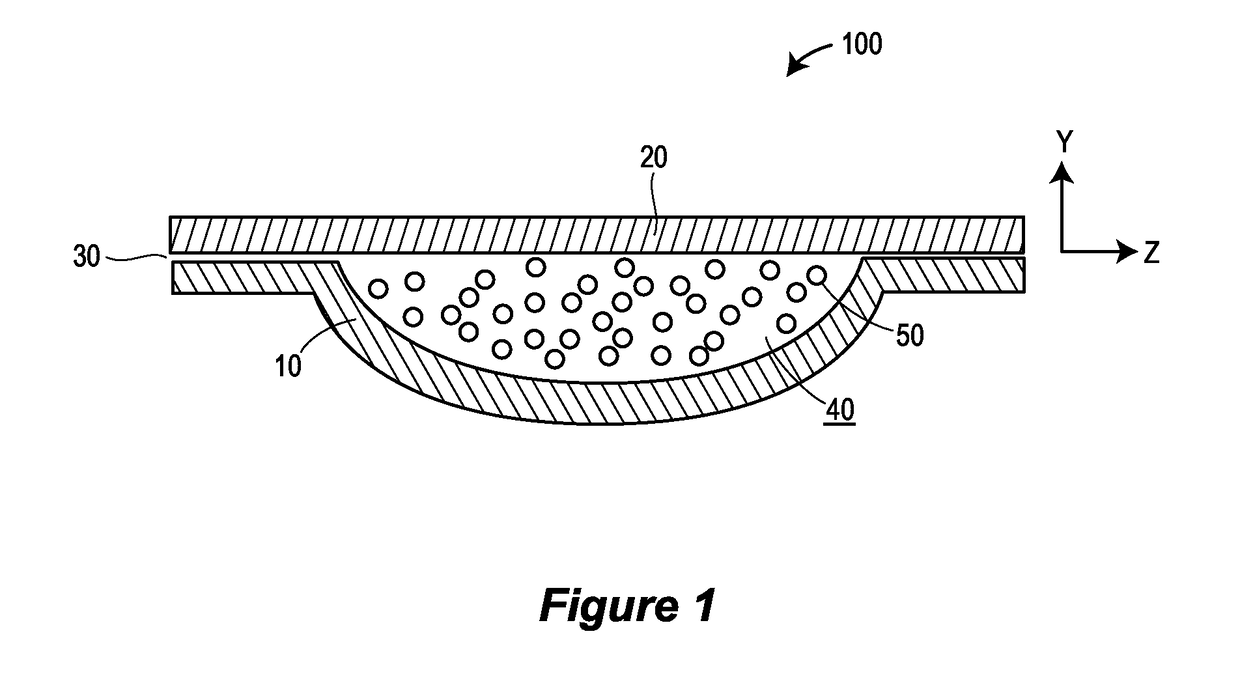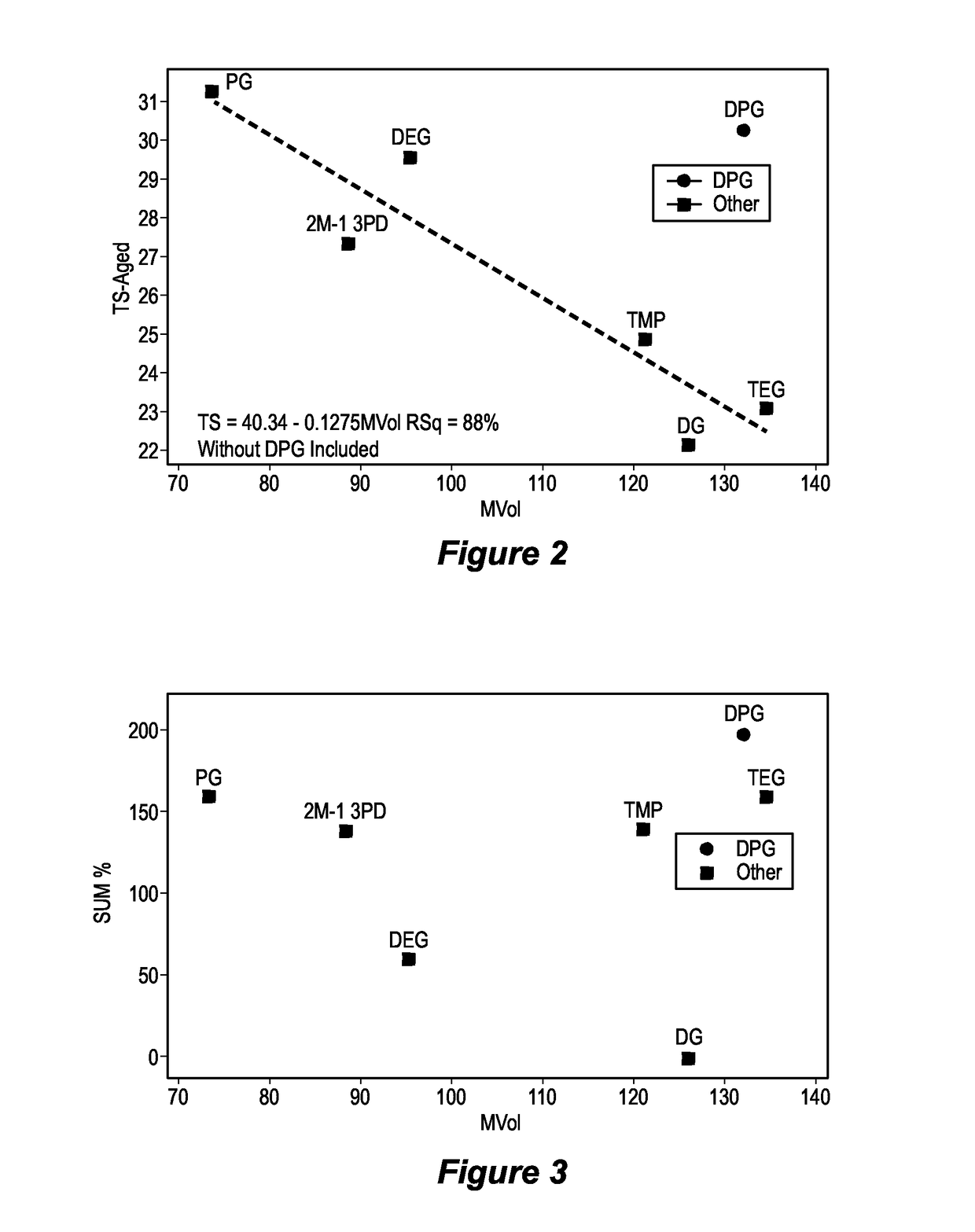Water-soluble polyvinyl alcohol film with plasticizer blend, related methods, and related articles
a polyvinyl alcohol film, plasticizer technology, applied in the direction of detergent compositions, detergent compounding agents, chemistry apparatus and processes, etc., can solve the problems of film residue on items within the wash, environmental concerns and energy costs, and arises
- Summary
- Abstract
- Description
- Claims
- Application Information
AI Technical Summary
Benefits of technology
Problems solved by technology
Method used
Image
Examples
example 1
Plasticizer Blend Series 1
[0209]Example 1 represents a series of water-soluble films based on a blend of PVOH homopolymers and three different plasticizers, including glycerin, sorbitol, and one from a series of different polyol plasticizers. The PVOH homopolymer blend is a 50 wt. % / 50 wt. % blend of a first partially hydrolyzed PVOH homopolymer having a 13 cP 4% solution viscosity and a second partially hydrolyzed PVOH homopolymer having a 23 cP 4% solution viscosity. The films included (i) their respective PVOH homopolymer resins (100 weight parts per hundred resin weight parts (phr)), (ii) glycerin plasticizer (21.7 phr), (iii) sorbitol plasticizer (5.7 phr), (iv) a polyol plasticizer (11 phr), (v) a modified starch filler (about 2-4 phr), (vi) surfactants and other process aids (about 5-7 phr), and (vii) residual water. The polyol plasticizer was variously propylene glycol (PG), 2-methyl-1,3-propanediol (2M-1,3-PD), diethylene glycol (DEG), trimethylolpropane (TMP), dipropylene ...
example 2
Plasticizer Blend Series 2
[0212]Example 2 represents a series of water-soluble films based on a blend of PVOH homopolymers and three different plasticizers, including glycerin, one from a series of sugar alcohol plasticizers, and propylene glycol (PG) or dipropylene glycol (DPG). The PVOH homopolymer blend is a 50 wt. % / 50 wt. % blend of a first partially hydrolyzed PVOH homopolymer having a 13 cP 4% solution viscosity and a second partially hydrolyzed PVOH homopolymer having a 23 cP 4% solution viscosity. The films included (i) their respective PVOH homopolymer resins (100 weight parts per hundred resin weight parts (phr)), (ii) glycerin plasticizer (21.7 phr), (iii) a sugar alcohol plasticizer (5.7 phr), (iv) propylene glycol or dipropylene glycol plasticizer (11 phr), (v) a modified starch filler (about 2-4 phr), (vi) surfactants and other process aids (about 5-7 phr), and (vii) residual water. The sugar alcohol was variously sorbitol (S), xylitol (X), or mannitol (M). Total plas...
example 3
Plasticizer Blend Series 3
[0213]Example 3 represents a series of water-soluble films based on a blend of PVOH copolymers and three different plasticizers, including glycerin, one from a series of sugar alcohol plasticizers, and dipropylene glycol. The PVOH copolymer blend is a 80 wt. % / 20 wt. % blend of a first partially hydrolyzed PVOH copolymer including monomethyl maleate (sodium salt) comonomer (MMM) and a second partially hydrolyzed PVOH copolymer including an acrylamido methylpropanesulfonic acid (sodium salt) comonomer (AMPS). The films included (i) their respective PVOH copolymer resins (100 weight parts per hundred resin weight parts (phr)), (ii) glycerin plasticizer (16.2 phr), (iii) a sugar alcohol plasticizer (10.4 phr), (iv) dipropylene glycol plasticizer (10.4 phr), (v) a modified starch filler (about 2-4 phr), (vi) surfactants and other process aids (about 5-7 phr), and (vii) residual water. The sugar alcohol was variously sorbitol (S), xylitol (X), or mannitol (M). T...
PUM
| Property | Measurement | Unit |
|---|---|---|
| melting point | aaaaa | aaaaa |
| Tensile Strength Test | aaaaa | aaaaa |
| Tensile Strength Test | aaaaa | aaaaa |
Abstract
Description
Claims
Application Information
 Login to View More
Login to View More - R&D
- Intellectual Property
- Life Sciences
- Materials
- Tech Scout
- Unparalleled Data Quality
- Higher Quality Content
- 60% Fewer Hallucinations
Browse by: Latest US Patents, China's latest patents, Technical Efficacy Thesaurus, Application Domain, Technology Topic, Popular Technical Reports.
© 2025 PatSnap. All rights reserved.Legal|Privacy policy|Modern Slavery Act Transparency Statement|Sitemap|About US| Contact US: help@patsnap.com



